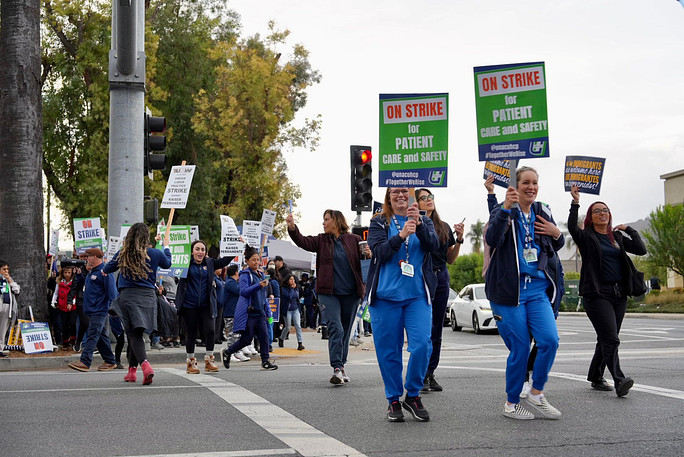
Roughly 31,000 Kaiser Permanente healthcare workers have walked off the job this week in California and Hawaii, protesting stalled contract negotiations and what they describe as unsafe staffing levels that put patients and employees at risk.
Their strike began at 7 a.m. Tuesday and will go until 7 a.m. on Sunday.
The workers on strike are members of the United Nurses Associations of California/Union of Health Care Professionals (UNAC/UHCP). The union said that it has bargained in good faith with Kaiser since May to try to address dangerous staffing levels and stagnant pay, but Kaiser has failed to offer adequate solutions.

The Power of One: Redefining Healthcare with an AI-Driven Unified Platform
In a landscape where complexity has long been the norm, the power of one lies not just in unification, but in intelligence and automation.
Kaiser said it has been working with the union for months to reach a fair deal and called the strike “unnecessary and disruptive.”
Inside the dispute
Kaiser is one of the largest, most well-resourced health systems in the country. It operates 40 hospitals and more than 600 medical offices across eight states and Washington, D.C., with a workforce of more than 200,000 employees. It also runs a health plan with 12.6 million members.
Last year, the health system made $115.8 billion in operating revenue and generated a profit of nearly $13 billion. It paid CEO Gregory Adams a salary of $15.6 million.
Kaiser also has investments totaling more than $100 billion — both domestically and abroad — in areas such as fossil fuels, for-profit prisons, alcohol companies, casinos and military weapons. In the past, union leaders have pointed to these investments as evidence that Kaiser has ample resources to address workers’ demands but does not always choose to prioritize them.
The health system is no stranger to labor disagreements. In the past five years, it has faced multiple strikes from unionized groups of nurses and other healthcare workers — mainly over staffing shortages, working conditions and wages.
Kaiser is currently negotiating contracts with the Alliance of Health Care Unions, which is a coalition of 23 unions representing about 60,000 Kaiser employees. Within that broader negotiation, UNAC/UHCP members are the ones striking this week — other unions in the alliance are at various stages of bargaining, and most are not striking yet.
During these negotiations, Kaiser has offered wage increases of 21.5% over four years, but UNAC/UHCP is demanding “an excessive wage increase” of 25% over the same period, the health system said.
“The seemingly small percentage difference between the two proposals actually means significantly more because it is multiplied across 60,000 employees and causes related benefit increases over four years. The difference between a 21.5% and a 25% increase is about $300 million a year in salary alone by the end of the contract,” Kaiser said in a statement.
Kaiser’s current payroll for employees in the Alliance of Health Care Unions is $6.3 billion per year. Its proposed wage increase would raise pay by a total of $1.9 billion over four years, and the UNAC/UHCP’s demand would increase pay by more than $2.2 billion.
This additional cost would mean more rate increases for Kaiser’s members and patients, the health system stated.
UNAC/UHCP sees things differently than Kaiser.
“Kaiser’s public messaging highlights a ‘21.5% wage increase over four years,’ but what it doesn’t mention is years of wage freezes during record inflation, cuts for new union members and the real daily impact these conditions have on patient care,” the group said in a statement.
The union also pointed out that Kaiser has consistently increased its insurance rates over the years, regardless of the status of its labor contracts — arguing that these raised rates are caused by underlying cost pressures within the healthcare system, such as skyrocketing drug prices and excessive coverage denials.
Additionally, UNAC/UHCP highlighted the fact that Kaiser holds $66 billion in reserves, saying that it is “fighting for resources to go to patient care, not Kaiser executives or company reserves.”
The union says it’s not about the money
UNAC/UHCP said it rejects Kaiser’s mischaracterization of the dispute as one that is just about wages.
“The employer is putting out these messages — a false narrative, an untruth — about why we are outside the hospital, outside the workplaces, outside the clinics, when we should be inside. They’re telling the public that it’s about the money, it’s about the wages. That’s the farthest from the truth. This is about respect. This is about dignity. This is about ensuring quality patient care,” Charmaine Morales, a Kaiser nurse and president of UNAC/UHCP, said on Tuesday while speaking to a crowd of healthcare workers on strike outside Kaiser’s hospital in Baldwin Park, California.
She acknowledged that the strike is a personal sacrifice for employees and their families, given Kaiser doesn’t pay workers on strike — but to her and the others gathered outside the picket line, it is a necessary step to secure a better future for healthcare workers.
Another employee — Cameron Cook, a nurse anesthetist at Kaiser’s hospital in Redwood City, California — said that he and the other nurses in his unit can no longer tolerate the strain that chronic understaffing places on themselves and their patients.
“We lost about 25% of our colleagues from the Kaiser system to other systems within the Bay Area. We are now seeing more workloads, longer patient wait times, and we unionized two years ago to elevate our voice to hopefully force Kaiser to address these issues. In response, they have spent the last 18 months at the bargaining table — stalling, delaying and essentially retaliating against us for organizing,” Cook declared during a Wednesday morning phone interview he took from the picket line.
While the strike may disrupt patient care in the short term, it alerts the public that patient care is already being compromised and could continue to deteriorate further if staffing shortages don’t get solved, he added.
In his view, the strike is meant to push Kaiser to formally acknowledge the staffing and patient care issues in a contract rather than making informal promises.
“Patients suffer when there are gaps in care,” Cook remarked. “Maybe we stay extra to fix that, or we come in extra tomorrow to help out our colleagues. Kaiser has taken advantage of that compassion. They have taken advantage of our vigilance, and we simply have recognized over the last two years that we cannot continue to keep doing extra to float Kaiser so that they can continue to dole out million-dollar bonuses to their executives.”
Post-pandemic labor tensions go deeper than this
This strike fits into a broader post-pandemic trend of labor unrest among healthcare workers, driven primarily by understaffing, burnout and uncompensated administrative work, noted Gerald Friedman, a labor union expert and economics professor at the University of Massachusetts.
Nurses and physicians are dealing with heavier workloads than ever before due to increasingly complex administrative requirements and a lack of employees, yet their pay is failing to keep up with inflation. While this is going on, executives’ salaries are getting higher and higher on both the health system and payer sides. All of this is a sure recipe for a labor movement, Friedman explained.
He also noted that Kaiser’s strike will have a small immediate financial effect on the health system.
“Healthcare often has to be done in time. For building cars or something, before the strike, you stockpile, and after the strike, you speed up, maybe do a little overtime. But healthcare, if you aren’t taking patients in, they either don’t get care or go someplace else,” Friedman remarked.
The financial impact won’t be very damaging, though, he pointed out, as the strike will only last five days. Friedman said that short-term strikes like this don’t hurt the employer’s pockets that much, but they do signal the seriousness of labor demands.
In his eyes, strikes like the one happening across Kaiser facilities this week will continue to have a ripple effect across the U.S. healthcare system.
“There’s a lot of unrest boiling beneath the surface,” he declared.
A signal, not a shutdown
To one former health system executive, the strike’s brief duration indicates that the union is likely close to resolution but wants to show how serious it is about its demands to both Kaiser and its own members.
“When the union announces a five day strike, what does that tell you? I think it tells you that they’re probably pretty close to solving the issues,” said Chris Olivia, retired former executive at health systems including Bon Secours Mercy Health and Allegheny Health System.
He has been on both sides of healthcare labor disputes throughout his career — as a health system C-suite leader as well as a physician and former union member himself. He thinks a new contract will be reached within the next week or so.
While short-term strikes like this week’s tend to disrupt elective procedures because resources get shifted toward critical patients, hospitals can typically manage these operational impacts, Olivia noted.
Kaiser has been keeping its hospitals and medical offices open during the strike, though it is moving some appointments to virtual care and rescheduling certain elective visits. The health system said it is onboarding up to 7,600 temporary staff members to work during the strike, the majority of whom have worked at Kaiser before.
Olivia’s number one piece of advice to health system leaders going through contract negotiations with their workers is to be honest.
“One of the strategies I used was to be brutally honest with union leadership as to where you are economically. And if you have the ability to give the increase, ultimately, you want to show that you are a good fiduciary and steward of the assets in a hospital. As a hospital leader, you have to take care of your people in the end,” he remarked.
He highlighted the importance of transparency and partnership with unions, including integrating union input into some of the health system’s leadership decisions, to maintain trust and achieve outcomes that feel more fair.
Overall, Olivia believes the strike taking place at Kaiser this week is a measured action to send a signal — one that reflects the larger struggle across the U.S. healthcare system to retain workers and ensure safe, quality care.
Photo: UNAC/UHCP








